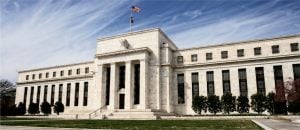By Wendy McElroy,
The U.S. Federal Reserve will not only issue its own cryptocurrency but will also make sure Americans use it. That’s the prediction of currency guru Doug Casey who has an uncanny record of being correct about economic and political trends. His latest book, Surviving Fedcoin: How to Protect Yourself (and Profit) from America’s Coming Currency Change, is a public bet that the U.S. government will issue its own bitcoin which Casey views as “the last arrow” in its money quiver.
How will the dynamic play out? He speculates,
“To start with, I suspect it’s going to be a parallel currency. Perhaps usable just within the U.S. which, in effect, would be a form of foreign exchange controls even more effective than the inability of Americans to open up foreign bank and brokerage accounts today [due to monetary control through FATCA]…I think it’s a near certainty that they’re going to do something like this and soon.”
Fedcoin
 Fedcoin refers to cryptocurrency and/or protocol established by a central bank. National banks could forge their own ‘bitcoin’ with comparative ease and bitcoin consultants have sketched possible scenarios on how.
Fedcoin refers to cryptocurrency and/or protocol established by a central bank. National banks could forge their own ‘bitcoin’ with comparative ease and bitcoin consultants have sketched possible scenarios on how.
In “Some Thoughts on Fedcoin – a Fed backed cryptocurrency” (March 9, 2015), Albert Szmigielski suggests, “[T]he Fed should premine all the currency that they want to issue on a blockchain….A premine happens where all (or part of) the cryptocurrency is issued in the first block, the genesis block. Then the Fed would just exchange the fedcoin for a dollar each.”
In the article entitled “Fedcoin” (October 19, 2014), J.P. Koning speculates, “The Fed would create a new blockchain called Fedcoin. Or it might create a Ripple style ledger by the same name. It doesn’t matter which. There would be an important difference between Fedcoin and more traditional cryptoledgers. One user—the Fed—would get special authority to create and destroy ledger entries….The Fed would…provide two-way physical convertibility between both of its existing liability types—paper money and electronic reserves—and Fedcoin at a rate of 1:1.”
Koning draws upon the work of mathematician and economist Sina Motamedi for “a more technical explanation for how this would work in the case of a blockchain-style ledger.”Motamedi advises, “The simplest way for a central bank to create its own crypto-currency is for it to fork the Bitcoin protocol into a new protocol that is unchanged in every way except that, going forward, the central bank would set and adjust the block mining reward at its discretion…. [L]ike paper currency, the central bank’s crypto-currency would be both decentralized (in transaction) and centralized (in supply).”

Discussions have been encouraged by the attention governments are directing toward Fedcoin. When the Bank of England released a paper (February 2015) that addressed the subject, the bitcoin-processing company Payment21 was not alone in asking, “Bank of England: Why might central banks issue digital currencies?”
In America, similar scenarios occur. In June 2016, central bankers from 90-some countries met behind closed doors in Washington D.C. and conferred with bitcoin experts. Federal Reserve Chair Janet Yellen opened the conference, which included the International Monetary Fund, the World Bank and Bank for International Settlements.
Adopting blockchain as a protocol to facilitate bank transfers was the focus but issuing ‘official’ digital currencies was actively explored. Adam Ludwin, CEO of the blockchain company Chain, delivered a speech entitled “Why Central Banks Will Issue Digital Currency.” Ludwin urged governmental attendees to use the revolutionary shift to create new assets for themselves.
[T]he medium of money has only changed a few times in history, from precious metals to bearer currencies to now our ledger-based electronic systems. Bitcoin and blockchain represent a transition to a new medium. This transition is often referred to as distributed ledger technology….But I find it more helpful to look back to bearer instruments, like banknotes, to appreciate what this new medium enables: a digital bearer instrument.
A key argument for Fedcoin is the perceived need to stabilize a cryptocurrency by pegging it to traditionally-issued money. The pegging would not necessarily be voluntary. Motamedi explains, “just like what happened with paper currencies, central banks will eventually step in to create their own crypto-currency protocols and forbid the use of any others. For simplicity, let’s call the central bank crypto-currency protocol BitDollar. Of course, these BitDollars would always be redeemable in regular dollars by the central bank, at least at first.”
Koning is more blunt. “Now is the time for the rebels to figure out how to create a stable-price version of bitcoin, before Darth Vader does it himself. Otherwise they may someday find themselves closing down their bitcoin startups in order to write code for the Empire.”
The Why Of It According to Casey
Doug Casey addresses America’s central banking system but the circumstances favoring a U.S. Fedcoin are mirrored throughout the Western world.
He doesn’t buy the stability theory. The U.S. government is bankrupt with liabilities far exceeding assets. Casey explains,
Social Security is bankrupt… Forty-seven percent of the people in this country are net recipients of money from the government… Officially, one-third of all the US government’s assets are student loans; little-known fact. About $1 trillion worth of them.
The greenback is semi-stabilized by being “the world’s money” but its privileged status is being shaken by nations such as China and Russia who aggressively seek alternative mediums for global commerce. Casey believes that yesterday’s monetary controls – quantitative easing and interest rates at near zero or below – cannot sustain a bankrupt dollar with waning global relevance. Yesterday’s methods are “going to come to an end….What can they [the feds] do?”
What the feds can do is cryptocurrency; Fedcoin is what’s coming to a start. And, according to Casey, the primary benefit to government would be a centralization of supply and a transparency of demand (or transactions), which could centralize control of the economy to an unprecedented extent.
Why would people use the cryptocurrency? Fedcoin would almost certainly emerge as a parallel currency which would be adopted due to government requirements for its use in paying taxes or accessing entitlements such as Social Security. Increasingly, however, Fedcoin would become a tool to push toward a cashless society because physical money provides a privacy that prevents government control.
Casey observes that the feds,
like to blame a lot of the problems on a lack of transparency, but with blockchain and the Fedcoin technology, they can see everything, everywhere. So it’s complete transparency ….Without cash, you have no privacy. If you have to put everything through a bank account, the government knows exactly what you’re buying, what you’re selling, how much you are earning. They’re in complete control; able to take what they want…including your entire account if you become politically undesirable.
Fedcoin would give the government God-like ability to track wealth. The justification will be to prevent criminal activities such as drug dealing and money laundering.

Counter-arguments can be easily made; for example, most black or gray market activities are peaceful and not properly criminal. But Casey focuses on the harm inflicted on the prosperity and freedom of average people. “[P]eople that are dealing in what’s called the underground economy are actually providing useful goods and services,” he observes. “[I]f the government extracts its 30 or 40 percent in taxes, which they will be able to do now with Fedcoin, [that] is going to hurt the economy, not help it. It will help the U.S. government, but that’s different from the economy in America.” The government would grow richer.
It would also become a more powerful engine of social control. In terms of privacy, Fedcoin could become the anti-cash. “If I’ve got a $100 bill in my wallet or a bunch of 10s and 20s,” Casey explains, “I can spend them on anything I want with anybody I want and nobody knows. With blockchain….[the feds] know exactly who’s getting the money and what it’s being spent for. It can be programmed [perhaps through a mechanism simiar to smart contracts] so that certain transactions can’t take place….So you are pretty well blocked in.”
Fat people could be prevented from buying sugar; gun owners could be cut off from ammunition; teenagers could be banned from buying beer, cigarettes or video games. The possibilities seem almost infinite. In doing so, Fedcoin would merely extend existing policies under food stamp programs that prohibit spending on alcohol, casinos or strip clubs. The efficiency would be so much greater, however, that the difference of degree would become one of kind. The government could “prohibit anything without even passing a law….If your Fedcoin smartphone or chip isn’t programmed to let you buy that, how are you going to get it?” Politically controversial items, like a gun registry, could become irrelevant.
One of Casey’s dystopian predictions seems doubtful to me, however. It is the idea that many or most Americans would embrace being physically “chipped.” But, then, I may simply have more confidence in average people when it comes to recognizing their own self-interest.
The Shadow Of Solution?
Casey likens the potential currency revolution to the Industrial Revolution. The technologies developed then gave unprecedented freedom and literally ‘life’ to the common man; the human life-span and population increased dramatically.
Bitcoin and blockchain are equally liberating to the individual but revolutionary technologies also challenge the status quo. And, so, entrenched powers attempt to co-opt their use.
Whether governments will succeed is not clear; they may be thwarted by their own incompetence or by the intrinsic decentralization of cryptocurrencies. It seems clear, however, that governments will make the attempt. And when they do, the best response is a better technology that sprints forward and leaves those who wish to ‘tame’ it coughing on its dust.
Those on the cutting edge of technology are today’s freedom fighters.

